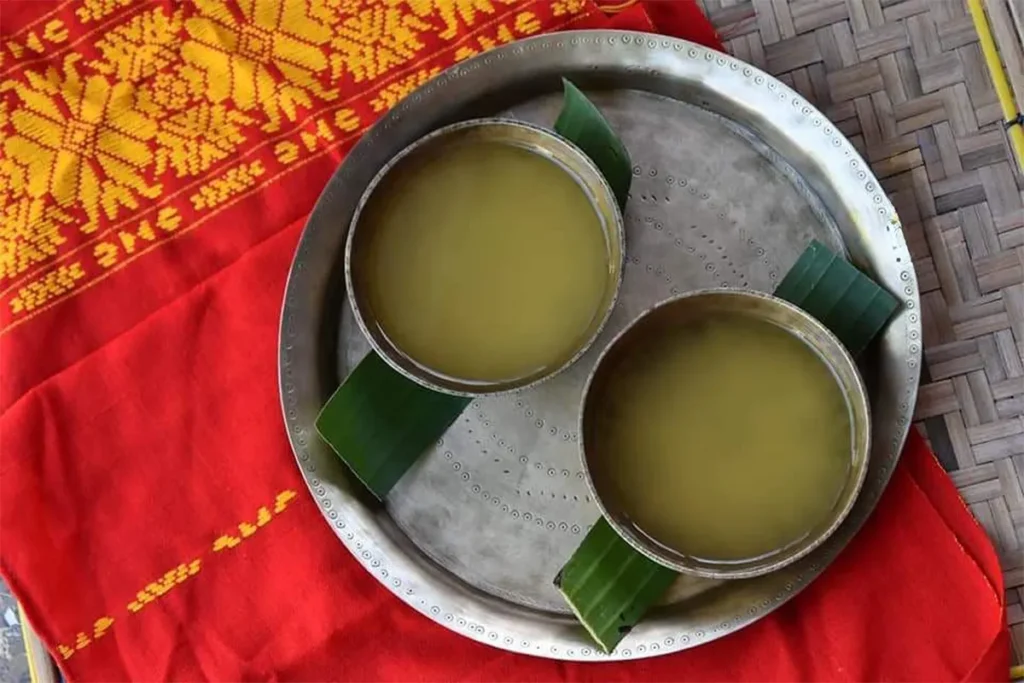Apong Diaries: Brewing Liquid Sunshine from the Hills!
Namaste Dosto! Kem cho? Kem che? Sat Sri Akal! Chef Curry Do’pyaza here, back in your kitchens (and hearts!) with a brew so special, it whispers tales of ancient hills and joyous celebrations. Today, we’re diving deep into the world of Apong, a traditional rice beer from the beautiful lands of Arunachal Pradesh and Assam.
Think of Apong as a warm hug on a chilly evening, a taste of community, and a celebration of life, all rolled into one delicious drink.
When the Apong Flows:
Apong isn’t just a drink; it’s woven into the very fabric of life in these regions. You’ll find it flowing freely during:
- Bihu: The vibrant harvest festival of Assam.
- Solung: The Adi tribe’s agricultural festival in Arunachal Pradesh.
- Weddings and Births: Marking joyous occasions with a communal toast.
- Everyday Life: A comforting drink after a long day of work in the fields.
A Sip of History:
Apong’s history is as old as the hills it comes from. Passed down through generations, the art of brewing Apong is a closely guarded secret within families. It represents a deep connection to the land and a respect for traditional knowledge. The recipes and techniques vary from village to village, making each Apong brew unique and special.
Let’s Get Brewing!
Don’t be intimidated! Making Apong at home is a rewarding experience. While the traditional method can be quite involved, I’ve simplified it for you, without compromising on the authentic taste.
Prep Time: 20 minutes (plus soaking time)
Cooking Time: 6-8 hours (fermentation)
Ingredients You’ll Need:
- Bora Saul (Sticky Rice): 2 cups
- Ranu Tablet (Rice Cake Starter): 1 tablet (available in Indian grocery stores or online)
- Water: As needed
Let’s Get Cooking (and Fermenting!)
- The Rice Bath: Thoroughly wash the Bora Saul until the water runs clear. Soak it in clean water for at least 4-6 hours, or even overnight. This will help the rice cook evenly and release its starches.
- Steaming the Goodness: Drain the soaked rice and steam it in a steamer or a large pot with a steamer basket. Make sure the rice is cooked through and slightly sticky. It should take around 20-25 minutes.
- Cooling Down: Spread the cooked rice on a clean, flat surface to cool completely. This is crucial! Warm rice will kill the yeast in the Ranu Tablet.
-
The Magic Ingredient: Crush the Ranu Tablet into a fine powder. This is your starter culture, the key to fermentation!
-
Mixing and Mingling: Once the rice is completely cool, gently mix in the Ranu powder, ensuring it’s evenly distributed.
-
The Waiting Game: Transfer the mixture to a clean, airtight container (a glass jar or a ceramic pot works best). Add a little water, just enough to create a slightly moist environment.
-
Fermentation Station: Seal the container and store it in a cool, dark place for 6-8 hours. This is where the magic happens! The Ranu will work its wonders, converting the rice starches into alcohol.
-
Adding Water: After 6-8 hours, add more water to the container, about 4-5 cups, depending on your desired strength.
-
Straining and Sipping: After 24 hours, strain the mixture through a clean cloth or a fine-mesh sieve. The liquid you collect is your Apong!
Chef Curry’s Tips for Apong Perfection:
- Hygiene is Key: Ensure all your utensils and containers are squeaky clean to prevent unwanted bacteria from spoiling your brew.
- Temperature Matters: Keep the fermentation environment cool (around 20-25°C) for optimal results.
- Patience is a Virtue: Don’t rush the fermentation process. Let the Ranu do its job!
- Taste Test: Sample your Apong after 24 hours and adjust the water content to your liking.
Cooking Medium Options:
- Steaming: You can steam the rice on a gas stove, induction stove, or even in a microwave with a steamer attachment.
- Fermentation: The fermentation process is best done at room temperature in a cool, dark place.
Nutritional Information (Approximate, per serving):
Since Apong is a fermented beverage, the nutritional content can vary. However, it generally contains:
- Calories: Moderate
- Carbohydrates: From the rice
- Alcohol: Varies depending on fermentation time and water content.
Serving Suggestions:
- Serve Apong chilled or at room temperature.
- Enjoy it with traditional Assamese or Arunachali cuisine.
- Share it with friends and family during festive occasions.
Call to Action:
So there you have it, folks! My simplified version of Apong. I urge you to try this recipe at home. Experience the joy of brewing your own traditional beverage. Share the Apong with your friends and family and introduce them to a taste of Northeast India. Happy brewing!
